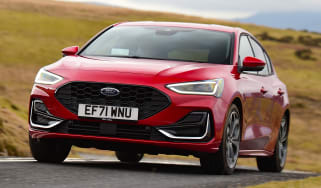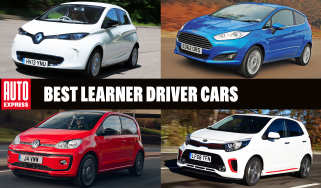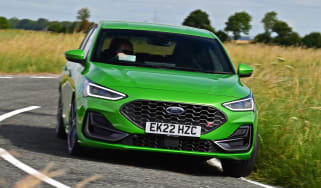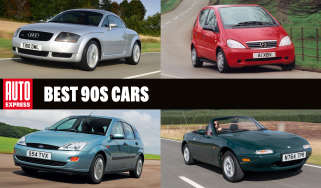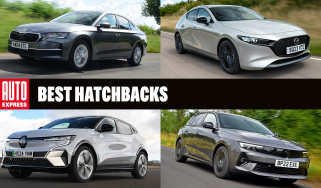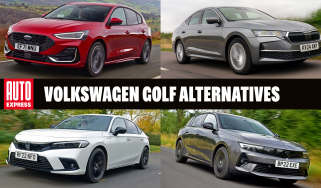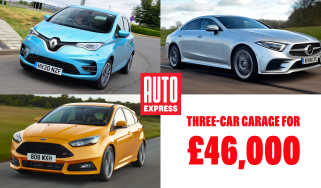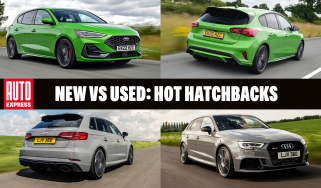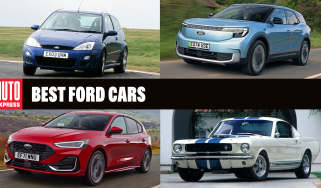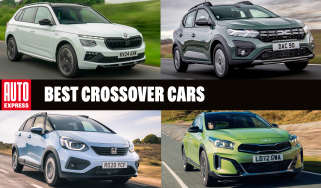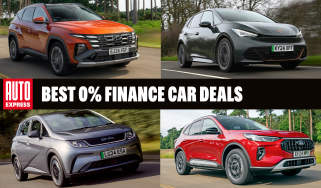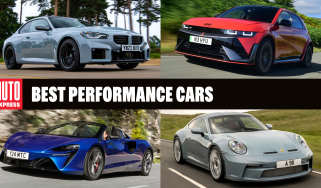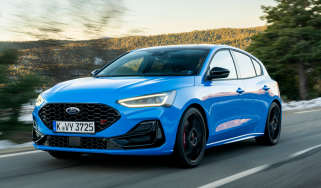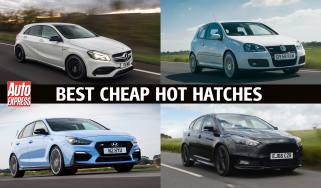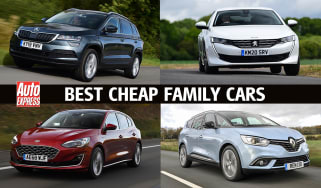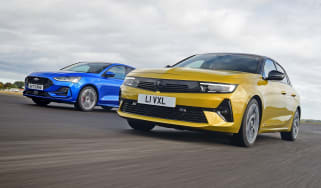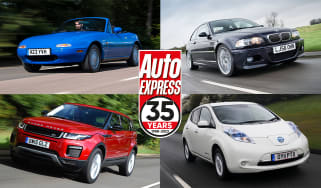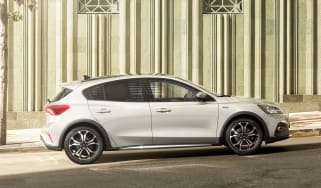Ford Focus (2018-2025) review
The Ford Focus is a great-handling family hatchback that matches its rivals on interior quality and cabin space

Just so you know, this is an older review of the 2018-2025 Focus. If you are interested in information about a used Ford Focus, or news about the latest Ford models, please follow the links provided.
The Ford Focus is one of the mainstays of the British car market, and it’s easy to see why. The well-judged chassis delivers a composed, comfortable and enjoyable drive on UK roads, with excellent body control and responsive steering. The engines – particularly the 1.0-litre EcoBoost 125PS version – are punchy enough but also refined.
The latest Mk4 Focus has better cabin space than its predecessors too, plus quality that’s pretty much a match for the best in class. With keen pricing and finance offers sealing the deal; the latest Focus should be on the shortlist of any buyer looking for a new hatchback.
About the Ford Focus
The Ford Focus was a game changer when it hit the market at the end of the 1990s, offering a blend of style, practicality and driving characteristics that were a step-change from the often porridgy hatchbacks around at the time.
There have been four generations of Focus now, and twenty years on it’s still one of the best family all-rounders that money can buy. The success of the Focus is reflected in its name. Ford’s engineering and marketing departments have stuck rigidly to the blend of characteristics that underpinned the original model’s appeal. As such, the latest Focus is as entertaining and pleasurable to drive as it is practical and affordable to own.
Used - available now

2021 Ford
Focus
39,965 milesManualPetrol1.0L
Cash £14,000
2023 Ford
Focus
23,011 milesManualPetrol1.0L
Cash £14,837
2020 Ford
Focus
35,039 milesManualPetrol1.5L
Cash £11,199
2021 Ford
Focus
30,428 milesManualPetrol1.0L
Cash £13,060The current line-up is offered in a trio of body styles that includes the established five-door hatch and estate models. They’re joined by the Active variant that seeks to cash in on the ‘crossover SUV’ craze, and features a slightly raised ride height and extended wheel arches.
The Mk4 Ford Focus certainly has the image to mix it with those more upmarket brands. The new design brought with it significant improvements in cabin space and practicality, but it has arresting looks too. There's a longer wheelbase, which improves space inside, while the cabin has been overhauled to create more room, too. The current Focus has a far bigger boot than the previous generation as a result, while an electric parking brake and revised cockpit means the front seats feel spacious, and the rear has decent legroom, too.
A facelift in 2022 saw exterior styling tweaks, further electrification to the engine range and a complete overhaul for the onboard tech and infotainment system.
It's at the front-end where the most noticeable changes have taken place; the Ford blue oval logo is bigger and now sits within a restyled grille, while the headlights have a more svelte look and incorporate the foglights in a new one-piece design. The tail-lights have also been updated, along with a new choice of alloy wheels.
The Focus is front-wheel drive only, and now offered exclusively with petrol power. The 1.0-litre EcoBoost petrol engine that features in all but the Focus ST hot hatch is available either in standard 123bhp form, or versions with 48v mild-hybrid technology producing 123bhp and 153bhp.
A six-speed manual gearbox is offered with the non-hybridized 123bhp version, while the less potent mild-hybrid variant uses a seven-speed auto transmission. If you opt for the 153bhp petrol car, you'll have the choice of either the manual or the auto, while the sporty 2.3-litre ST model delivers its 276bhp via a six-speed manual or seven-speed auto gearbox, too.
Ford has now removed EcoBlue diesel engines from the Focus line-up, but you'll be able to find secondhand examples featuring either a 118bhp 1.5-litre or 148bhp 2.0-litre motor, both paired with an eight-speed auto.
Titanium is now the starting trim level in Focus ownership, followed by Active and ST-Line, while 'X' versions of each specification are available, too. All models include a new 13.2-inch central touchscreen, running Ford's new SYNC 4 infotainment system, although each available trim includes a Style variant (from stock) running an older SYNC 2.5 or SYNC 3 set-up on an 8-inch display and without integrated sat-nav. However Apple CarPlay and Android Auto come standard on all new Focus models.
How much does the Ford Focus cost?
Prices for Titanium cars start from around £27,000, and rise to more than £30,000 for the top-spec ST-Line X hatchback, while the sporty ST model is around the £36k mark.
Engines, performance and drive
The first thing to know is that the Focus gets a couple of different suspension configurations depending on which engine you choose. Get one with the 1.0-litre EcoBoost petrol or the now-discontinued 1.5-litre EcoBlue diesel engine and you’ll get relatively simple twist-beam rear suspension; go for the 2.0 diesel (also no longer offered on the price list) and your car will feature a multi-link set-up. Picking ST-Line or ST-Line X lowers the set-up by 10mm, incidentally, regardless of which suspension layout is at the back.
It shouldn’t bother you much anyway because, regardless of suspension layout, the Focus is the best-handling family car around. Start your journey in town and you’ll find the car quick to respond when you turn the wheel to cut through traffic. But this doesn’t mean it’s nervous at speed; there’s just about enough play off-centre for the car to remain composed on motorways. It’s comfortable, too, the primary and secondary rides working nicely to soften all but the very sharpest of jolts from the road.
And when you find a twistier bit of road, the Focus trots out its party piece. Don’t expect the steering to chat away to you all the time, but the electrically powered set-up goes down as one of the best we’ve experienced in a family hatch. Suffice it to say that you will very quickly learn to lean on the Focus’ front end.
Of course, none of this front-end bite would matter if the rest of the package felt like it wasn’t playing its part in proceedings. There’s the faintest, fleeting feeling of weight transfer if you ask the Focus to change direction in a hurry, but it passes so quickly that it’s unlikely to ever be an issue. As a handling package, it’s extremely well-judged.
The standard six-speed manual gearbox is slick enough, although it does prefer a positive throw instead of tentative shifts. The eight-speed automatic, meanwhile, is not without the occasional glitch, but in general it’s a smooth enough performer. We still think that the VW Group’s dual-clutch DSG units are ever so slightly more polished than this torque converter auto, though.
0-62mph acceleration and top speed
The Mk4 Focus is only offered with petrol power now, but for a time it came with a mix of petrol and diesel engines. The core of the petrol range, badged EcoBoost, is a 1.0-litre three-cylinder engine that’s offered as a standard 123bhp unit, or with mild-hybrid assistance producing either 123bhp or 153bhp. 0-62mph is completed in 10.2s and 9.0s, respectively.
In the Focus mHEV, the turbocharged 1.0-litre three-cylinder EcoBoost petrol unit is linked to a belt driven starter-generator motor, with the aim of providing improved fuel economy and emissions. The 48-volt battery system can provide an extra 24Nm of torque when needed and reduce the load on the combustion motor. It also enables seamless engine shut-off and start up, with the driver able to choose when the new start-stop system kicks in to allow emissions free coasting; at 9mph, 12mph or 16mph.
We tested the most modest of the Focus diesels – the 118bhp 1.5-litre EcoBlue – before it was removed from the price list and feel it's a decent option if you know you’re going to rack up big mileages. It’s not quite as sweet and hushed as the EcoBoost when cruising along, but it maintains speed reasonably well.
The EcoBlue diesel engine performs reasonably well, although it does need revving to get the most out of it as there's not much torque below 2,000rpm, and this can be a little frustrating when pulling out of junctions or when overtaking. At least the six-speed manual gearbox has a positive shift to make life easier.
The ST model sits at the top of the range, fitted with a 276bhp 2.3-litre petrol engine which helps the hot hatch sprint from 0-62mph in 5.7s if get the six-speed manual version. Models fitted with the seven-speed automatic take 5.8 seconds to complete the same benchmark sprint.
MPG, CO2 and running costs
While the Mk4 Ford Focus was offered with a choice of petrol or diesel power at launch, Ford's ubiquitous 1.0-litre EcoBoost petrol engine is now the only option. It features mild-hybrid technology and comes in two power outputs, with the 123bhp and 153bhp versions capable of returning up to 52.3mpg and 54.3mpg respectively. Both emit 116g/km of CO2.
When we tested the base 123bhp EcoBoost six-speed manual model (the only version that doesn't feature mild-hybrid assistance) against a VW Golf and Vauxhall Astra, the Focus managed to achieve 44.6mpg, compared to the Golf's 44.3mpg and 47mpg we saw from the Astra.
The now-discontinued 1.5-litre 118bhp EcoBlue diesel delivers a claimed 57.6mpg on the combined WLTP test cycle and 120g/km of CO2.
The more powerful 2.3-litre ST petrol manual model achieves 35.3mpg, although CO2 emissions are much higher at 183g/km. The automatic version manages just a touch better with an average of 35.8mpg and 182g/km.
Any Focus Estate model will trail its five-door hatch slightly on emissions and fuel economy, but it remains competitive with its rivals on this front.
Insurance groups
The most basic Ford Focus models should be fairly cheap to insure. Trend models start at group 12, while a 153bhp ST-Line version comes in at group 16. The most expensive to insure is the Focus ST, although it still sits in group 27 on the 1-50 scale.
Our Car Tax Checker tool lets you check your tax status and renewal date in seconds. Check your VED car tax now...
Depreciation
The Mk4 Focus had predicted residual values of around 42 per cent over three-years and 36,000-miles, but the introduction of the facelifted model and a stronger used market mean that owners should see an average return of around 54 per cent of their car's original list price after the 36-month period.
To get an accurate valuation on a specific model check out our free car valuation tool...
Interior, design and technology
Ford played things a bit safe with the fourth-generation Focus’ styling; it was clearly an evolution of the old car’s, but also incorporated some styling cues that we recognised from its little brother, the Fiesta – especially around the front end. The view along the sides is dominated by the longer wheelbase – the gap between the front and rear axles – which is the longest it’s ever been on a Focus.
A facelift in 2022 brought in styling tweaks to the front and rear ends, with changes to the light clusters, grille and bumpers, while the Ford logo now sits within the grille rather than on top. There are new alloy wheel designs to choose from, too.
On-board technology has been given a thorough overhaul, with the Focus now running Ford's latest SYNC 4 infotainment software. All models now include a 13.2-inch touchscreen, while the X pack versions add a 12.3-inch digital instrument display.
The interior quality is good enough to rival the best in class – without delivering a knockout blow on the VW Golf, perhaps. There are soft-touch padded materials up high, mixed with metallic finishes depending on which trim level you go for, and while there are harder plastics (notably on the centre console between the front seats), they’re generally in areas that you’re not likely to touch all that often anyway. It’s good to see padded door liners and flock-lined storage areas, too; they give the cabin a bit more of an air of luxury and help to cut down vibrations and rattles.
Sat-nav, stereo and infotainment
Ford’s SYNC 3 infotainment system was snappy enough, quick to respond to inputs and blessed with a reasonably simple interface with big buttons that were easy to use on the move. But the Blue Oval's latest SYNC 4 set-up is simply one of the very best in this class, and the 13.2-inch central touchscreen is one of the largest of any family hatchback too.
The fonts and graphics are simple, clear and consistent, loading times are excellent, and routes boot up more quickly than in rivals like the Vauxhall Astra, although the VW Golf is also very speedy in this area.
Digital heating and ventilation controls are often not the most user-friendly, but we really like them in the Mk4 Focus, while buyers will benefit from improved wireless connectivity, which includes Apple CarPlay, Android Auto and over-the-air updates.
We found that the 12.3-inch digital driver's display in Focus rivals the VW Golf's Virtual Cockpit system for clarity, although the Golf and the Vauxhall Astra offer more customisation when it comes to displaying information.
Practicality, comfort and boot space
One of the Mk3 Focus’s biggest problems was a shortage of interior space, so Ford went back to the drawing board for the Mk4 Focus and extended the wheelbase (the gap between the front and rear axles) by more than five centimetres.
That might not seem like a lot, but all of that extension has been handed over to the cabin occupants – particularly those in the rear seats. And the result is accommodation that is perfectly comfortable for four six-footers, even on a long journey. There’s even room for a third occupant in the middle of the rear seats – and with no big transmission tunnel in the floor, they should have somewhere to put their feet, too.
Up front there’s good shoulder and headroom, and small touches there have improved the overall feeling of space; there’s a switch-operated electric parking brake across the range now, instead of a bulky handbrake lever. However, if you're a taller driver, you may find getting in and out a little bit trickier. That's because if you have the seat set back, you might catch yourself on a piece of plastic trim that sticks out from the door frame.
The boot isn’t the largest in the class, but it’s more than respectable – and only a few litres off the capacity of a VW Golf when the rear seats are in place. Lower them and the Focus actually trumps some of its main rivals on out-and-out load-lugging space.
Dimensions and size
The fourth-generation Ford Focus is 4,378mm long, 1,979mm wide (including mirrors), and 1,471mm tall. Those figures make it a full 12cm longer than a VW Golf, although the Ford is only a few millimetres longer than another of its main rivals, the Vauxhall Astra.
It’s wider than both of those competitors, too, and you may want to take advantage of Ford’s optional door protectors. They extend around the edge of the door as you open it, protecting the metal from scrapes against walls and plaster.
Leg room, head room & passenger space
The Mk4 Focus is definitely the most practical version of the car to date; there’s room in the cabin for four six-footers to travel a long distance in comfort, and a fifth person could squeeze into the middle seat in the rear for a shorter trip. There are also ISOFIX points for child seats in both of the outer rear seats.
Boot space
The Focus is now one of the longest cars in the class, but Ford has clearly used that extra length to prioritise cabin space over boot capacity, because while the load bay of the car is up there with those of its rivals, it’s not exactly cavernous.
At 375 litres with the rear seats in place, the Focus gives away five litres to the capacity of the Golf. But fold the back row down and the positions are reversed; the Ford’s 1,354 comfortably exceeds the VW’s 1,270 litres. But of course, neither of these cars can get anywhere near the load-lugging ability of the Skoda Octavia, the undisputed family-car king of boot capacity.
There are a few side hooks in the Focus’s boot but it’s a little disappointing that Ford hasn’t seen fit to offer some more tricks in the boot floor itself – such as sticky ‘dividers’ that could stop your shopping from rolling around.
Towing
The 123bhp 1.0-litre EcoBoost model is rated to tow 1,000kg, while the 153bhp version has an increased capacity of 1,500kg. The powerful 276bhp ST models boasts the highest maximum braked trailer weight at 1,600kg, but the now-discontinued diesel models weren't far behind as they could tow up to 1,400kg.
Reliability and safety
The Focus is built on an all-new C2 platform, although we’re led to believe it shares knowledge and some technology with the underpinnings that have proven such a hit under the Fiesta in recent years. Even so, the new architecture does bring some risks on reliability – but at least the majority of the engines in the line-up are reasonably well-proven.
The Focus didn't feature in our 2022 Driver Power customer satisfaction survey, although Ford was well represented on the 75-car list with appearances from the Puma crossover, EcoSport small SUV, Kuga mid-size SUV and the ever-popular Fiesta supermini. The Blue Oval will be disappointed with a 25th-place finish (out of 29 manufacturers) in the best brands poll – only just ahead of Fiat, Dacia, and MG.
The new Focus has been tested by Euro NCAP’s crash-test team and scored a full five stars. It achieved 85 per cent for adult protection and 87 per cent for child occupant safety.
You can spec the optional Driver Assist Pack which brings adaptive cruise control, traffic sign recognition, lane centring and automatic main beam headlight functions. Other kit on offer includes evasive steering assist, blind spot monitoring with cross traffic alert, inflatable seatbelts and pre-collision assist with pedestrian and cyclist detection.
Warranty
The Focus comes with Ford’s standard warranty, which is over an industry standard of three years but does stretch to 60,000 miles during that period, which is on the generous side. Ford also offers the chance to extend cover to four years/80,000 miles and five years/100,000 miles.
Servicing
Ford offers its Protect Service Plan, which includes payment plans for scheduled services, along with extended Ford Assistance roadside cover. The Ford Protect Service Plan can be purchased any time before the first service is due.
Ford Focus Alternatives
While the first Focus had some very well-established rivals to unseat, including cars such as the Vauxhall Astra, VW Golf and Honda Civic, the breadth of competition is much wider today. The list of desirable contenders vying your cash now includes European rivals like the Peugeot 308, SEAT Leon and Skoda Octavia, as well as impressive challengers from East Asia like the Mazda 3, Kia Ceed and Hyundai i30. You’ll probably also want to take a look at some ostensibly more premium rivals, including the Mercedes A-Class, BMW 1 Series and Audi A3 Sportback.
Used and nearly new
Traditional family hatchbacks are coming under increasing pressure, with buyers appearing to favour stylish, high-riding SUVs instead of the long-established five-door hatch. This doesn't mean that used examples of Ford's iconic family car will be too hard to come by, however, as it's been on sale since 1998 and manufactured in a variety of body styles: three- and five door hatchbacks, a four-door saloon, a more practical estate model, a soft-top Coupe Cabriolet and even off-road inspired Active versions
The Focus RS model sets the standard for performance, but you'll find a huge choice of capable petrol and diesel-engined cars further down the range, while equipment levels even on lower-spec Zetec models is pretty generous.
Ford Focus history
Ford Focus Mk3: 2011-2018
A tidy Mk3 Ford Focus could prove to be a smart buy: good to drive, with decent engines and strong levels of kit, the package is made all the better by the model's keen pricing. Supply shouldn't be an issue as lots of examples reside on dealer forecourts, while many more are available via car supermarket-style outlets and through private sale.
Yes, the Volkswagen Golf is a little more refined and offers solid residual values, but in terms of bang for buck, the Focus is a great all-rounder. The 1.0-litre petrol cars will be cheap to run, while opting for diesel power means you'll benefit from excellent economy. Read our full Mk3 Ford Focus buyer’s guide here…
Ford Focus Mk2: 2004-2011
Buying a mainstream car that is over ten years old means that you'll probably have a strict budget in mind. The second-generation Focus was a sales success, so there will still be lots of examples to choose from and most should be pretty affordable.
Look out for post-2007 facelifted cars which included a style makeover and an upgraded interior, while the 2.5-litre Focus ST model could prove to be a performance bargain for the keen driver. Read our full Mk2 Ford Focus buyer’s guide here…
Ford Focus Mk1: 1998-2004
Launched in 1998, the Mk1 Focus was a replacement for the lacklustre Escort model and immediately set new standards for driving dynamics in the family hatchback class. Its obvious qualities were recognised when it was awarded the European Car of the Year title in 1999, and its sharp styling still holds up today.

